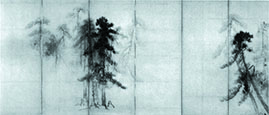- What is Japan ?
- What is traditional Japaneseart ?
- The flag of Japan
- A name of Japan
- 山紫水明 Scenic beauty
- 夏 Summer
- 冬 Winter
- 石にも神は宿る
- 春 Spring
- 秋 Autumug
- 松林図 A forest of the pine tree
- 梅林図 A forest of the Jpanese apricot tree
- 雪 Snow
- 日本の伝統文化の基本とは何なのか。日本の文化の始まりは紀元前の縄文時代や弥生時代にさかのぼる。 日本列島は山が多く、雨と水に恵まれ、日本の風土は稲作に過していた。
日本全国に稲作が広がるにつれ、人々の関心は天候の事となった。
- 太陽の膨大なエネルギーが地上に降り注がれて 、山川草木を豊かに生育させる。
そして動物- 目の前の自然を神々の姿に見立てる神話的自然観は、現実世界をさながら「神聖楽園」としてみなすことになる。
さらに日本には四季があり、その自然の光景はことさらに美しいものであった。
いつしか日本の文化は何よりも「美しい」ことを重視するようになる。
地球上の生命の元は太陽であった。太陽のカによってすべての生命がはぐくまれることを人々は昔から知っていた。 - 目の前の自然を神々の姿に見立てる神話的自然観は、現実世界をさながら「神聖楽園」としてみなすことになる。
- 太陽は偉大であるという考え方は神道という宗教的な考え方に発展していった。
- 「雅」という言葉は絢爛豪華の世界を指す。こうした「雅」志向は平安時代に「大和絵」を生む。
- さらに神道のもう一つの特徴は、「清浄世界」という考え方にある。
神道は穢れを嫌い、清いことを重視する。 神道の「清浄世界」は白を基本としながら、「わび ・さぴ」「滅び」 「幽玄」 「もののあわれ」の美につながっていく。
- また、禅のわぴ、さぴとは、個人の作為を排し一切を自然にまかせることにより生まれる美といえよう。そして禅や般若心経にみる「無」「空」の考えは装飾を究極的になくし単純化したミニマリズムを志向する。
中国より伝わった山水水墨画も多くの余白部分を残すことにより「無」の芸術を表現する。それは日本独自の「清浄世界」と合致するものであった。
- さらに「無我」という禅の境地は、自然と人間の主客未分の一体化をめざした。
「無」の世界、禅の世界は、白地に墨一色の山水画や、さらに抽象性を高めた枯山水の手法であらわされた 。- また、禅のわぴ、さぴとは、個人の作為を排し一切を自然にまかせることにより生まれる美といえよう。そして禅や般若心経にみる「無」「空」の考えは装飾を究極的になくし単純化したミニマリズムを志向する。
中国より伝わった山水水墨画も多くの余白部分を残すことにより「無」の芸術を表現する。それは日本独自の「清浄世界」と合致するものであった。
- また、禅のわぴ、さぴとは、個人の作為を排し一切を自然にまかせることにより生まれる美といえよう。そして禅や般若心経にみる「無」「空」の考えは装飾を究極的になくし単純化したミニマリズムを志向する。
- 枯山水で知られる龍安寺に敷き詰められた広大な白砂は、海であると同時に、大自然という空間を想起させる抽象化された世界ある。
- また、禅のわぴ、さぴとは、個人の作為を排し一切を自然にまかせることにより生まれる美といえよう。そして禅や般若心経にみる「無」「空」の考えは装飾を究極的になくし単純化したミニマリズムを志向する。
中国より伝わった山水水墨画も多くの余白部分を残すことにより「無」の芸術を表現する。それは日本独自の「清浄世界」と合致するものであった。
- また、禅のわぴ、さぴとは、個人の作為を排し一切を自然にまかせることにより生まれる美といえよう。そして禅や般若心経にみる「無」「空」の考えは装飾を究極的になくし単純化したミニマリズムを志向する。
- 神道によると、この世の世界はすべて「八百万の神」がつくったものである。人や動物、さらに大自然の山や石まて形あるものはすべて神々の面影を宿す 。
自然は神々であるという自然観が人々に生まれ、人間が神々と共存することができる至上の喜びを人々は感じた。
- その「大和絵Jの背景には金色や銀色が使われるが、これらはやはり現実の世界が太陽の光に包まれているという人々の幸福感を表している。
江戸時代に「大和絵」は尾形光琳や俵谷宗達などの琳派の興隆により「雅」は頂点を極めた。そして「雅」と「わぴ・さぴ」という対立した美学を神道はもっている。たとえばその代表的な例を挙げれば、尾形光琳の梅林図、長谷川等伯の松林図である。
- その「大和絵Jの背景には金色や銀色が使われるが、これらはやはり現実の世界が太陽の光に包まれているという人々の幸福感を表している。
- What are the foundations of Japanese traditional culture?
Japanese culture goes back to the ancient Jomon and Yayoi eras.
Japan is mountainous. Because of the islands'rain-blessed climate, Japan is suitable for rice growing.
As rice crops spread in all parts of Japan, people's concerns embraced matters of weather.
- The sun's huge energy pouring on the ground nourishes bountiful harvests
on mountainside and plain.
The origin of life on earth is the sun.
- Humans sensed intuitively that the sun fosters all life on earth, so sun
worship developed into the beliefs such as Shinto.
- According to Shintoist, a type of animism, the world is dominated by a
myriad of native gods.
All things which exist; humans, animals, plants, small stones, and huge mountains are believed to have been created by Gods and are reminders of those Gods.
The belief that each facet of nature corresponds to a God gives the supreme joy that human can coexist with Gods.
- A mythological outlook regarding nature as God brings paradise to the earthly
world.
Furthermore, the seasonal climate of Japan brings extraordinary beauty.
It is natural for Japanese culture to consider ”beauty”as the highest priority.
- While the word ”miyabi”points to a world of gorgeous magnificence, the
ae
- While the word ”miyabi”points to a world of gorgeous magnificence, the
aesthetic variant ”miyabi" describes a drawing technique "yamatoe"
of the Heian era.
- While the word ”miyabi”points to a world of gorgeous magnificence, the
aesthetic variant ”miyabi" describes a drawing technique "yamatoe"
of the Heian era.
- Moreover, the Wabi Sabi of Zen is a beauty created by leaving the natural
exist while excluding individual deliberation.
At the same time, the ideas ”mu”(void) and ”ku"(empty), seen in Zen and Heart Sutra,demand austere minimalism.
The sumi-ink landscape painting contains many unpainted areas. These white areas indicate the art of "mu”(void), and this technique resonates with the unique Japanese ”pure world" idea.
- While the word ”miyabi”points to a world of gorgeous magnificence, the
aesthetic variant ”miyabi" describes a drawing technique "yamatoe"
of the Heian era.
- While the word ”miyabi”points to a world of gorgeous magnificence, the
aesthetic variant ”miyabi" describes a drawing technique "yamatoe"
of the Heian era.
- Furthermore, Zen’s idea ”muga”(selflessness) pursues nonsubjective unification
between nature and human kind.
The selfless Zen world view was expressed by the sumi-ink landscape painting technique which describes a stylized landscape world in black on a white background.
- While the word ”miyabi”points to a world of gorgeous magnificence, the
aesthetic variant ”miyabi" describes a drawing technique "yamatoe"
of the Heian era.
- While the word ”miyabi”points to a world of gorgeous magnificence, the
aesthetic variant ”miyabi" describes a drawing technique "yamatoe"
of the Heian era.
- The Ryoan Temple is famous for this stylized landscape expressionism rendering
sea against vast white sand.
This mechanism helps us image the wide spread of the world of abstruct.
- While the word ”miyabi”points to a world of gorgeous magnificence, the
aesthetic variant ”miyabi" describes a drawing technique "yamatoe"
of the Heian era.
- While the word ”miyabi”points to a world of gorgeous magnificence, the
aesthetic variant ”miyabi" describes a drawing technique "yamatoe"
of the Heian era.
- Shint
- Shinto has an additional representative feature, its view of a ”Pure world”.
Shintoism shuns impurity.
Shintoism’s white-based ”pure world”leads to the beauty of ”wabi”,”sab”,”horobi”(ruination) , "yugen”( profound subtlety) and ”mono-no-aware”.
- While the word ”miyabi”points to a world of gorgeous magnificence, the
aesthetic variant ”miyabi" describes a drawing technique "yamatoe"
of the Heian era.
- While the word ”miyabi”points to a world of gorgeous magnificence, the
aesthetic variant ”miyabi" describes a drawing technique "yamatoe"
of the Heian era.
Shintoism’s white-based ”pure world”leads to the beauty of ”wabi”,”sab”,”horobi”(ruination) , "yugen”( profound subtlety) and ”mono-no-aware”.
- While the word ”miyabi”points to a world of gorgeous magnificence, the
aesthetic variant ”miyabi" describes a drawing technique "yamatoe"
of the Heian era.
- Shinto has an additional representative feature, its view of a ”Pure world”.
Shintoism shuns impurity.
- Gold and silver were used for the background in ”yamatoe”to express a feeling
of happiness in a world wrapped in sunlight.
Yamatoe reached its peak in the Edo era through the rise of the ”Rimpa” school,represented by artists including Kourin Ogata and Soutatsu Tawaraya.
The opposing aesthetics of ”miyabi”,”wabi”and ”sabi”make up Shintoism.
Typical examples referred to are “A forest of the Japanese apricot tree" by Kourin Ogata and “A forest of the pine tree ”by Touhaku Hasegawa.

-
- “日“ means the sun.
“日本”means the country of the sun. Kanji of Japan is hieroglyph of the sun. - 日本の 「日」の字は太陽の象形文字である。
- A country name and flag of Japan is doctrine of the Shinto.
日の丸は神道の教えを表している。
- “日“ means the sun.
-
-
This space means the Universe
This circle means the sun.
Red means the Life (blood).
White means sacredness andpurity.














